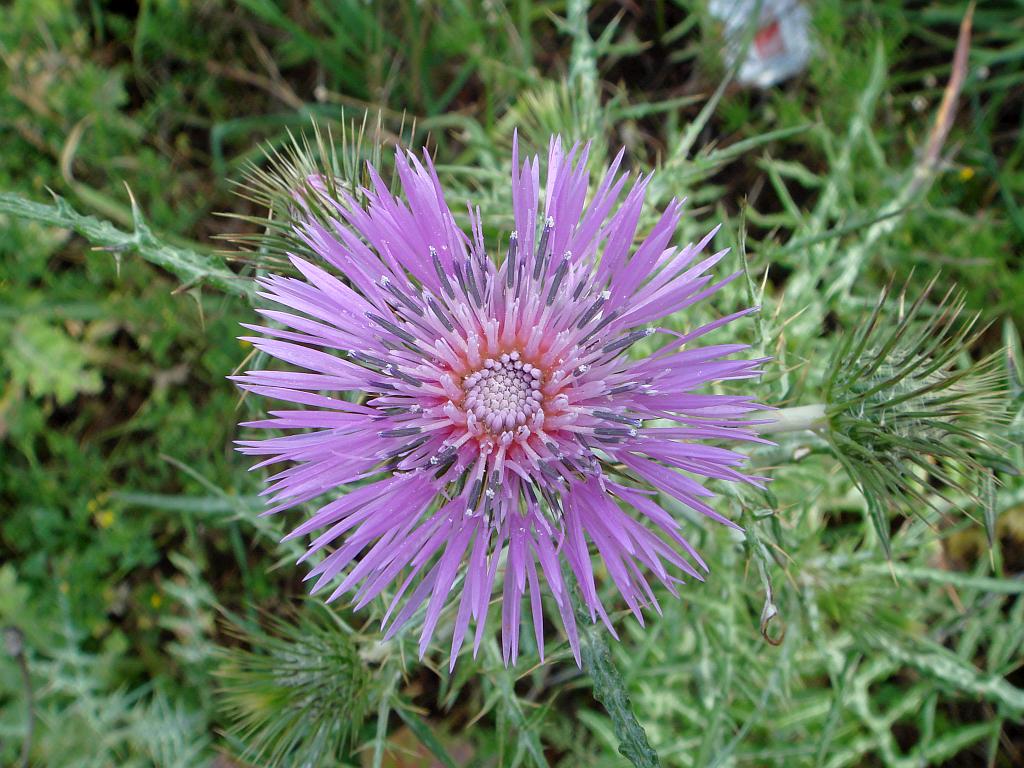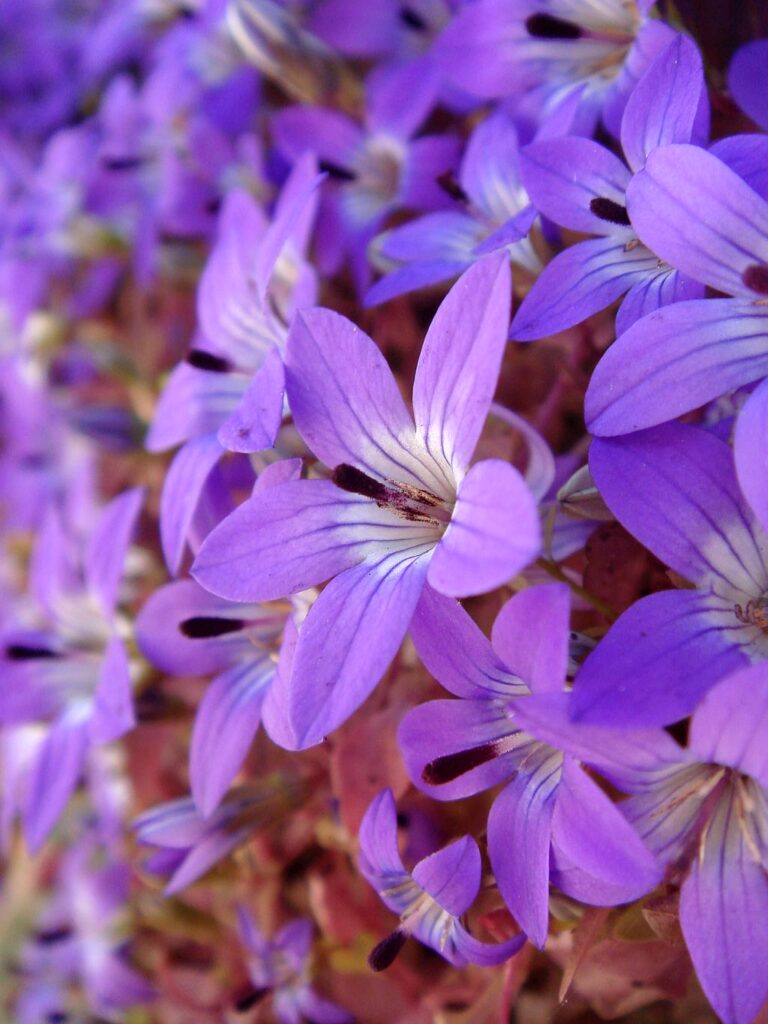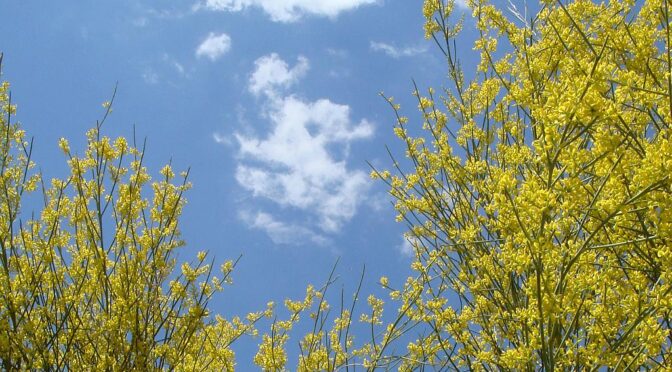Road side verges are full of colour and cereal fields can turn red with poppies or yellow with false fennel during late May and into June. As the weeks progress spring blooms will be turning to seed and the golden browns of summer will begin to dominate the lower landscapes. Howeve,r the later flowering of the mountainous plants means that there is still plenty to discover in what is known as the ‘hedgehog zone’. Here are a few of the June flowers in the Sierra de Grazalema to look out for.
Purple Milk Thistle (Galactites tomentosa)
The flowers are generally around 3 cm in width, lilac to purple in colour or occasionally white. The stems and flower buds appear white as they are covered in fine hairs. The leaves are narrow and spiny, with white markings. They can grow to around 80 cm in height. Found on uncultivated or barren ground, well-drained soils, pastures and roadsides. Distribution: SW and S of Europe, NW Africa.

Spanish Oyster Thistle (Scolymus hispanicus)
This is a robust, branched thistle which is usually wider at the base and can grow more than a metre tall. The yellow flowers are around 2–3 cm diameter. The new basal leaves are collected when in season as a wild vegetable. They are often cooked with scrambled eggs or with chickpeas in a stew and are locally called “Tagarninas”.
Distribution: Mediterranean area.

Campanula (Campanula specularioides)
This delicate looking annual campanula forms small mats of leaves, topped by purple flowers with a white centre and dark purple veining. It can be found in limestone rock crevices and in built walls. Although it can grow profusely around the village of Grazalema, it is very localised. (Also known as Campanula lusitanica subsp. Specularioides) Distribution: Sierra de Grazalema and Serranía de Ronda.

Pale Stonecrop (Sedum sediforme)
This is a perennial, evergreen plant which can grow in the most inhospitable areas, including baking hot clay roof tiles. They store moisture in the small plump leaves which are a bronze / green in colour. It can reach a height of around 50cm when in flower. Each upright stem is topped by a radial spray of small yellow flowers of 5 petals. Can be seen in arid rocky areas, rock crevices, in dry-stone walls and rooftops.
Distribution: Mediterranean area.

Putoria (Putoria calabrica)
This is a low growing, spreading evergreen, which is woody at the base and forms a dense mat. During the summer it is covered in tight clusters of delicate, pink tubular flowers, which are very popular with butterflies and bees. The flowers are followed by red berries, and they can occasionally be seen bearing both. Found on vertical limestone cliffs, rocky areas and slopes. Distribution: Mediterranean area.

Pyramidal Orchid (Anacamptis pyramidalis)
An elegant orchid smothered in pink flowers which are densely arranged in a cone shape on the flowering scape. May reach 30cm in height and can be seen in meadows and rocky exposed slopes. Unlike the bee-orchid group, these are pollinated by butterflies and moths. Distribution: Central and Southern Europe, Mediterranean region.

Nature Plus – Grazalema
Your local guide at Nature Plus – Grazalema is Sue Eatock. Originally from the UK, she has lived in Grazalema since 2005 and specializes in the wild plants and animals of the Sierra de Grazalema Natural Park.
Below is a list of a few more June flowers in the Sierra de Grazalema.
Yellow
Retama (Lygos sphaerocarpa)
Biting Stonecrop (Sedum acre)
Pistorinia breviflora
Squirting Cucumber (Ecballium elaterium)
Star Hawkbit (Rhagadiolus stellatus)
Rabbit’s Bread (Andryala integrifolia)
Prickly Lettuce (Lactuca serriola)
Chondrillia (Chondrilla juncea)
Bladder Vetch (Anthyllis tetraphylla)
St. Johnswort (Hypericum perforatum)
Yellow Bartsia (Parentucellia viscose)
Great Mullein (Verbascum giganteum)
False fennel (Ridolfia segetum)
Elaoselinum foetidum
Red and orange
Field Poppy (Papaver rhoeas)
Long-headed Poppy (Papaver dubium)
Prickly Poppy (Papaver argemone)
Rough headed poppy (Papaver hybridum)
Grazalema Poppy (Papaver rupifragum)
White
Oregano (Origanum vulgare subsp. virens)
White stonecrop (Sedum album)
Sedum brevifolium
Sedum hirsutum subsp. baeticum
Sedum rubens
Saxifraga bourgeana
Saxifraga globulifera
Hormathophylla spinosa
Wild Carrot (Daucus carota)
White Flax (Linum suffruticosum)
Bladder Campion (Silene vulgaris)
Black nightshade (Solanum nigrum)
Elderflower (Sambucus nigra)
Mediterranean Daphne (Daphne gnidium)
Clematis (Clematis vitalba)
Hedge parsley (Torilis arvensis)
Bear’s-breeches (Acanthus mollis)
Evergreen Rose (Rosa sempervirens)
Silver sage (Salvia argentea)
Fragrant virgin’s bower (Clematis flammula)
Traveller’s Joy (Clematis vitalba)
Purples blues and pinks
Oleander (Nerium oleander)
Barrelier’s Sage (Salvia barrelieri)
Globe Thistle (Echinops ritro)
Sheep’s bit scabious (Jasione Montana)
Purple Rush Loosestrife (Lythrum salicaria)
False grass-poly (Lythrum junceum)
Phlomis herba-venti
Cleonia lusitanica
Pistorinia hispanica
Cliffhanger (Chaenorhinum Villosum)
Chicory (Cichorium intybus)
Blue Aphyllanthes (Aphyllanthes monspeliensis)
Putoria (Putoria calabrica)
Spanish love-in-a-mist (Nigella papillosa subsp. papillosa)
Love-in-a-mist (Nigella damascena)
Opium poppy (Papaver somniferum)
Tree Honeysuckle (Lonicera arborea)
Pitch Trefoil (Bituminaria bituminosa)
Cottonball Clover (Trifolium tomentosum)
Self-heal (Prunella vulgaris)
Dog Figwort (Scrophularia canina)
Mediterranean lineseed (Bellardia trixago)
Blue lettuce (Lactuca tenerrima)
Staehelina (Staehelina dubia)
Cupid’s dart (Catananche caerulea)
Purple starthistle (Centaurea calcitrapa)
Hairy pink (Petrorhagia dubia)
Common Centaury (Centaurium erythraea)
Wild Artichoke (Cynara humilis)
Cardoon (Cynara cardunculus)
Scabious (Lomelosia simplex)
Mournful Widow (Sixalix atropurpurea)
Delphinium pentagynum
Stavesacre (Delphinium staphisagria)
Sand Spurrey (Spergularia purpurea)
Rampion bellflower (Campanula rapunculus)
Campanula velutina
Campanula specularioides
Campanula lusitanica
Sedum mucizonia
Asperula hirsuta
Orchids
Lizard Orchid (Himantoglossum hircinum)
Bug Orchid (Anacamptis (Orchis) coriophora)
Robust Marsh Orchid (Dactylorhiza elata)
Bee Orchid (Ophrys apifera)
Red Helleborine (Cephalanthera rubra)
Tongue Orchid (Serapias lingua)
Small-flowered serapias (Serapias parviflora)
Ronda Today
Everything you need to know before you visit Ronda “The city of dreams” in Andalucia. https://www.rondatoday.com/
Visit Cádiz
Planning on visiting Cádiz? Tourist information. Monuments. Hotels. Activities. City guides: https://visitingcadiz.com/
The Caminito del Rey
Find tickets for the Caminito del Rey: https://www.caminodelrey.es/
Wildside Holidays – Spain
Take a trip on the Wildside! Discover the wildlife and nature of Spain, its Natural and National Parks and find the top wildlife, activity and walking holiday companies.
Iberia Nature Forum
Discover the Iberia Nature Forum – Environment, geography, nature, landscape, climate, culture, history, rural tourism and travel.
I’ve been living in this lovely area of Western Andalucia for the last 20 years or so and dedicate most of my time to the running of English language tourist information websites for the towns of Cádiz, Ronda, Grazalema, the famous or infamous Caminito del Rey, and also Wildside Holidays, which promotes sustainable and eco-friendly businesses running wildlife and walking holidays in Spain. My articles contain affiliate links that will help you reserve a hotel, bus, train or activity in the area. You don’t pay more, but by using them you do support this website. Thankyou!
